Type species: Smerinthus dyras Walker, 1856.
A genus of 23 species occurring in the Palaearctic and Oriental regions, with one endemic to the western Palaearctic.
IMAGO: Forewing buff, brown, or grey, with transverse lines and dentated outer margins. Hindwing apex rounded. Proboscis reduced to two separate lobes, non-functional. Antenna with prolonged setae in male; terminal segment short. Abdomen without broad dorsal scales, but densely clothed in thin spines. Tibiae spinose, but hindtibia without median pair of spurs. Tarsus stout, the spines of one row of the underside more or less erect in a comb-shape. Proportional length of hindwing veins D2 and D3 variable, but D2 never twice the length of D3, sometimes even shorter than D3.
Genitalia. In male, valva separated by a distal incision to form a ventral and dorsal lobe; modified friction scales absent; sacculus represented by a very strongly chitinized hook curving upwards. Phallus without processes, but more or less rugose or granulose at the tip.
OVUM: Very large for the size of the moth, oval, pale whitish green, sometimes with brownish markings.
LARVA: Typically sphingiform, green, rough with fine tubercles, with either yellow or white lateral stripes, resembling Smerinthus. Anal flap and parapodia covered with large granulations. Horn straight or slightly curved and granular. Young larvae usually have a pronounced apical point to the head.
PUPA: Rugose, glossy, with no pronounced proboscis. Very similar to Smerinthus, i.e. short and thick, but with two pronounced frontal ridges. Coxal piece and ante-spiracular ridges present. Cremaster broad, short, usually with a pair of apical spines.
HOSTPLANT FAMILIES: Trees and shrubs mainly of the Juglandaceae, Rosaceae, Lauraceae, Tiliaceae, Malvaceae and Fagaceae.
UK: Oak Hawkmoth, F: Sphinx du Chêne; Sphinx du Chêne Vert, D: Eichenschwärmer, RUS: Dubovyi Brazhnik, NL: Eikepijlstaart, CZ: Lišaj dubový, H: tölgyfaszender, E: esfinge de la encina; esfinge del roble, PL: Nastrosz debowiec; Debnik nadobny, FIN: Tammikiitäjä, I: Sfinge della quercia, HR: hrastov ljiljak, N: Eikesvermer.
Sphinx quercus [Denis & Schiffermüller], 1775, Ankündung syst. Werkes Schmett. Wienergegend: 41, 244.Type locality: Vienna district, Austria.
(Taxonomic note. Although this is a variable species with a number of colour forms, some of which, such as f. mesopotamica O. Bang-Haas and f. schirasi O. Bang-Haas, show geographical tendencies, none warrants subspecific status.)
[Further details on this species, as well as photos of all stages, can be found on Lepiforum.]
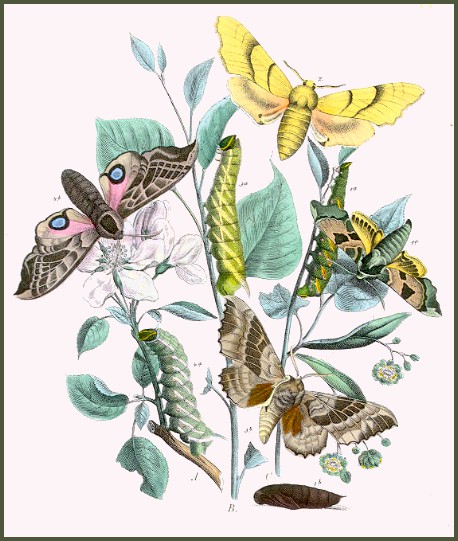
Holarctic; western Palaearctic region. Pleistocene refuge: Polycentric -- Holomediterranean refugia (de Lattin, 1967).
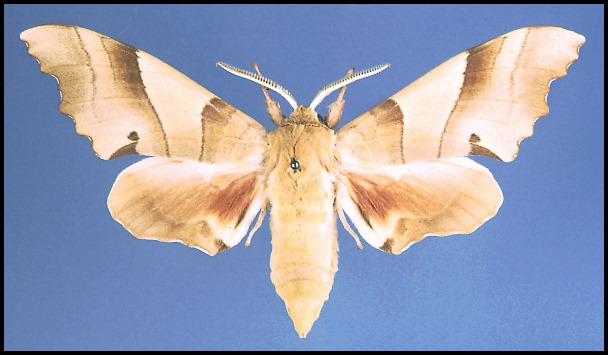
Wingspan: male 85--100mm; female up to 125mm. Similar to a large, pale, ochreous Laothoe populi although, when at rest, the hindwings do not project above the forewings. Ground colour very variable, ranging from very pale ochreous or buff to dark brown (f. brunnescens Rebel); the latter is the predominant colour form among females in Asia Minor and Mesopotamia. In some, smoky grey is the main colour, while individual brown females may have yellowish white transverse lines on the wings, or a complete absence of any line. Another form has bright pink basal areas on the hindwings with the ventral surface of a similar colour (f. mesopotamica Bang-Haas).
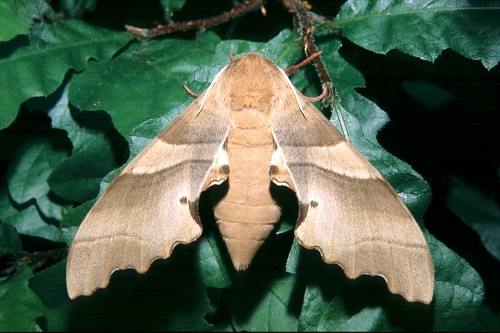
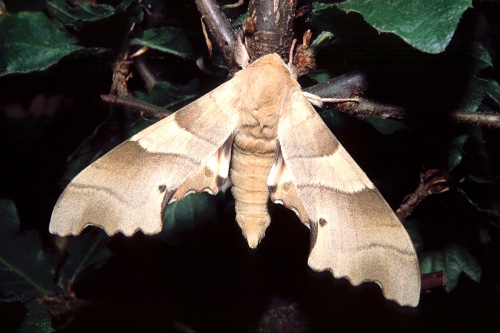
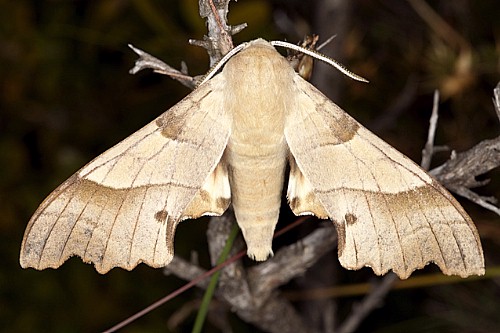
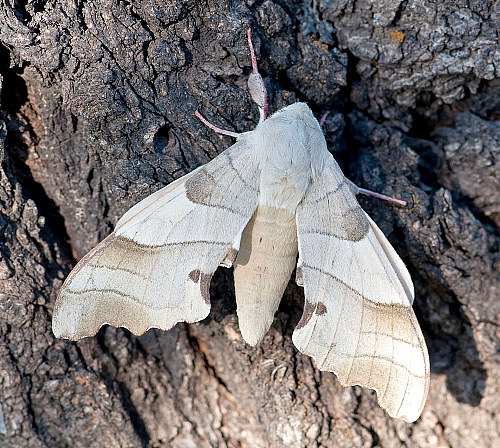
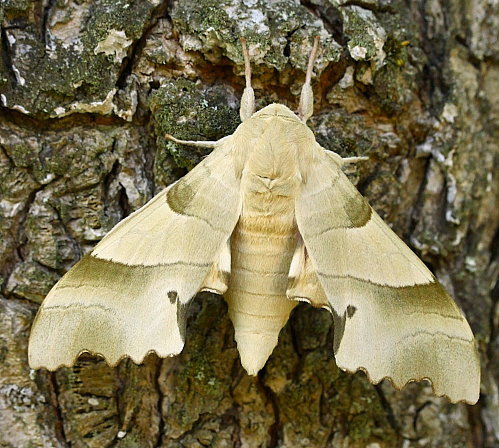
Dry, sunny, wooded hillsides with a preponderance of young, shrubby oaks are favoured, usually in areas where the soil is of a light, gritty nature. Occurs up to 1500m in Spain, but in Lebanon is restricted to around 1200m (the oak zone). Adults rest by day suspended amongst foliage where they resemble dead leaves. A few may be found on tree trunks, especially Quercus suber (cork oak), having climbed there after emergence. It is here that mated females can sometimes be discovered, having parted from the male before dawn. As neither sex feeds in the adult stage, flowers have no attraction, although both sexes come to light.
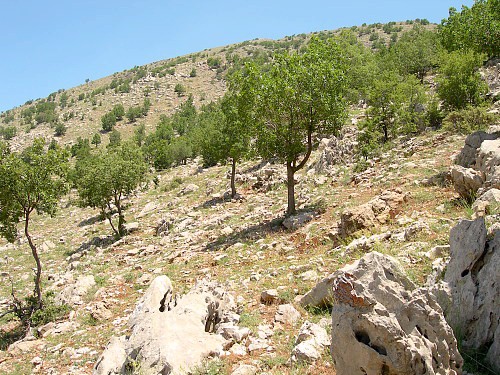
Bivoltine; May/June, with sometimes a partial to full second emergence in August/September. Sometimes, during a warm spring, individuals can even be found in April in southern Spain. However, Thiele (2016) states that there is only one generation in southern France, with a prolonged emergence from mid May to early August.
OVUM: Large (3.5 x 3mm), oval, pale green; up to 100 laid per female. Deposited singly on the underside of leaves, preferably on somewhat isolated bushy saplings. Prior to hatching, the young larva is clearly visible through the shell (see below).
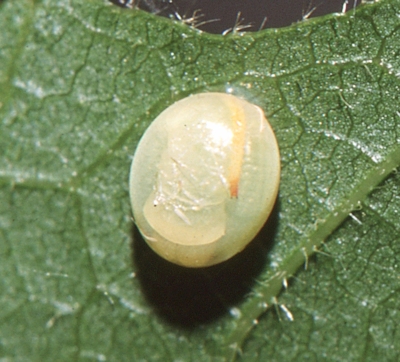
LARVA: Full-fed 65--80mm. Dimorphic: green or bluish white.
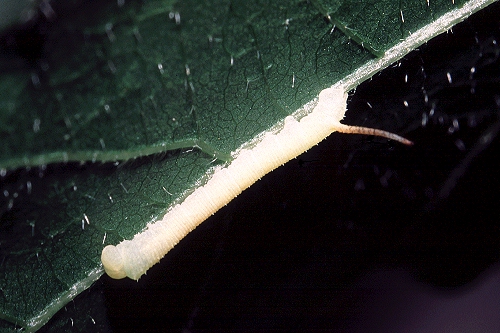
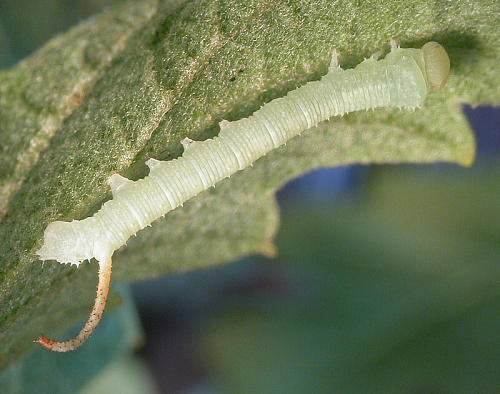
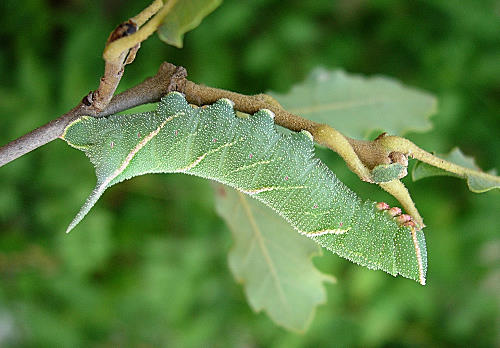
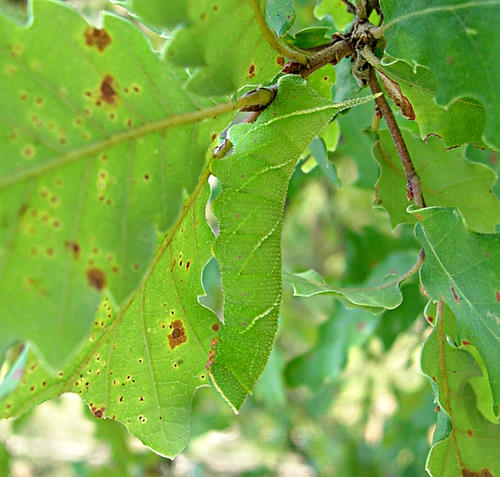
On hatching, the 8mm-long, whitish-green larva may or may not eat the eggshell before wandering off to find a leaf on which to moult. Not until the second instar does normal feeding commence from beneath that leaf. At this stage the final body coloration is established: an apple- or blue-green ground colour speckled with very fine yellow tubercles. Laterally, the body is marked with seven oblique yellow stripes, alternately wide and narrow, the last of which merges with the horn. In the first and second instars the horn is enormous -- more than half the body length, and pale orange with a pale yellow base and encircling band of the same colour below the darker tip. Later, the basic colour of the now smaller and stouter horn changes to mid blue. Head concolorous with body, with yellow or orange cheek lines, and heavily spined in the first four but not in the final two of the six instars. When this species feeds on Q. ilex, the larva tends to be greyish-blue with white stripes and tubercles. Whatever the colour form, a fully-grown larva is extremely well camouflaged as it hangs in a leaf cluster. Prior to pupation, it becomes reddish-brown before descending from its hostplant during the night or early morning.
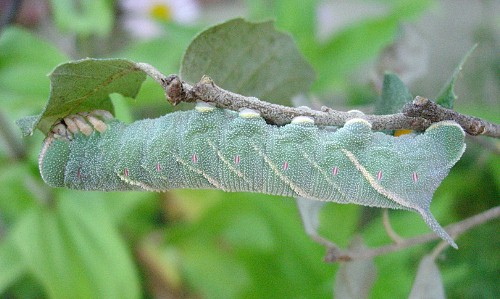
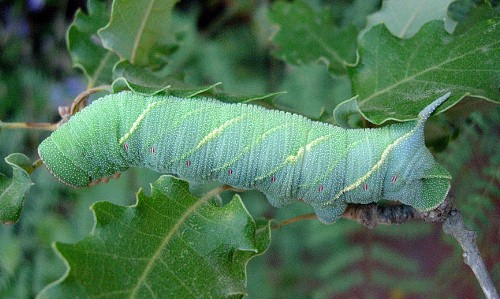
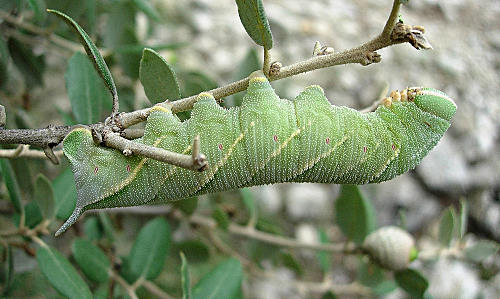
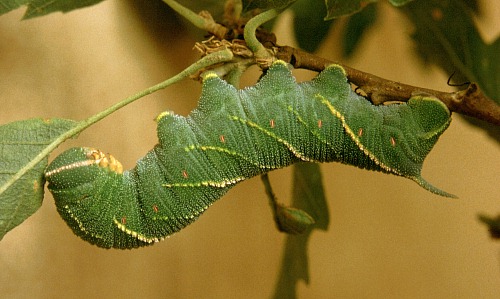
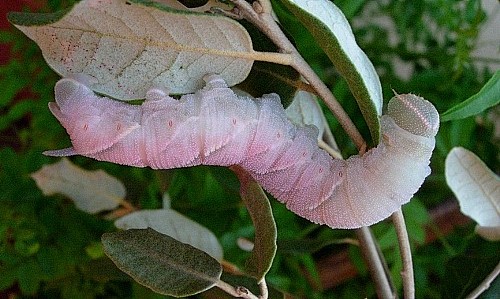
Occurs between June and September, depending on latitude, altitude and generation.
![A plate from Hübner (1793[1842]). A plate from Hübner (1793[1842]).](hub1793.jpg)
Hostplants. Quercus, especially dry-leaved species such as Quercus suber, Quercus ilex, Quercus coccifera, Quercus pubescens, Quercus ithaburensis and Quercus cerris. Shrubby bushes are preferred to large mature trees.
Pérez De-Gregorio et al. (2001) also give Fraxinus for Spain. This is so unusual as to require further study.
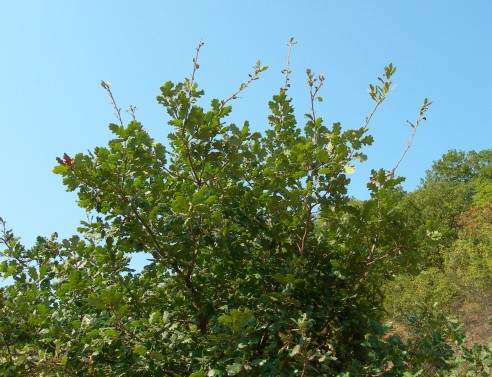
PUPA: 45--55mm. Rugose but glossy, dark reddish brown with a double-tipped cremaster. Pupation is noticeably deep in fine, gritty soil, where a large chamber is constructed. The overwintering stage.
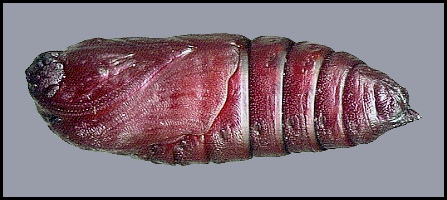
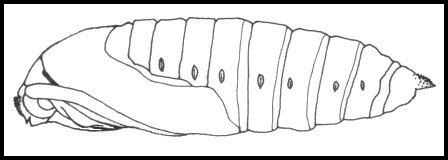
Tachinidae: Drino (Palexorista) imberbis (Wiedemann, 1830).
From the Rif and Atlas Mountains of Morocco (de Lepiney, 1929; Zerny, 1936; Rungs, 1981), Portugal (Corley, 2004; Pires & Corley, 2007) and Galicia, Spain (Pino Pérez et al., 2009), across southern and central Europe (de Freina & Witt, 1987) to Greece (Fritsch, Stangelmeier, Top-Jensen & Bech, 2014; Weidlich, 2016) and Turkey (Bang-Haas, 1938; Daniel, 1939; de Freina, 1979; Ayberk & Akkuzu, 2005; Okyar, Yurtsever, Aktaç & Çakan, 2009; de Freina, 2012; Okyar, 2012; Akin, 2012; Baron, 2014; Kemal & Koçak, 2016; Koçak & Kemal, 2018; Kemal, Koçak & Uçak, 2018; Seven & Aykal, 2022), and the island of Rhodes (Roger Perkins, pers. comm 2021), southern Ukraine and the Crimea (Savchuk & Kajgorodova, 2015; Khalaim, 2022), Moldova (Tugulea & Tugulea, 2020), Transcaucasia (Derzhavets, 1984), Armenia (Didmanidze, Petrov & Zolotuhin, 2013; Wąsala & Zamorski, 2015), the Republic of Georgia (Didmanidze, Petrov & Zolotuhin, 2013; Streltzov et al., 2022), Azerbaijan (Didmanidze, Petrov & Zolotuhin, 2013; Snegovaya & Petrov, 2021), Daghestan, Russia (Yakovlev et al., 2022), western Kazakhstan (Danner, Eitschberger & Surholt, 1998), Uzbekistan (Zarafshan State Reserve, Samarkand area) (Omonov, Rahimov, Askarova & Khomidova, 2023), Lebanon (Zerny, 1933; Ellison & Wiltshire, 1939; Talhouk, 1997), Israel (Bytinski-Salz, 1966; Eisenstein, 1984; Müller et al., 2005b), western and northern Jordan (Müller et al., 2005a; Katbeh-Bader, 2014), northern Iraq (Wiltshire, 1957; Kemal & Koçak, 2018c; Bahrouz Jaff, iNaturalist 2023) and south-west Iran (Shiraz) (Bang-Haas, 1938; Ghassemi, Alemansoor & Alehossein, 2010). Also from northern Iran (Brandt, 1938; Lehmann & Zahiri, 2011) to the lower Volga River (Eversmann, 1844) and southern Turkmenistan (Derzhavets, 1984).
This species occurs at low population densities so its presence may go undetected for long periods. Moreover, Marumba quercus is prone to wander beyond its normal range and vagrants have been discovered in northern France (Herbulot, 1971; Rougeot & Viette, 1978), the Netherlands (Meerman, 1987), Bavaria (Forster & Wohlfahrt, 1960), southern Switzerland (Vorbrodt & Müller-Rutz, 1911; Schweizerischer Bund für Naturschutz, 1997) and near Moscow, Russia (Danner, Eitschberger & Surholt, 1998).
Extra-limital range. None.
 Return to species list
Return to species list